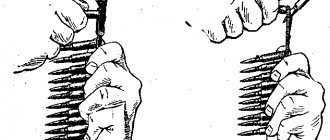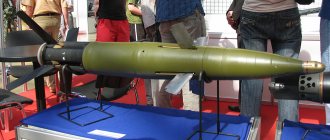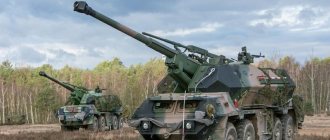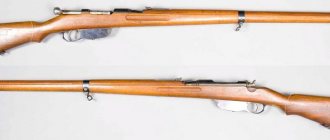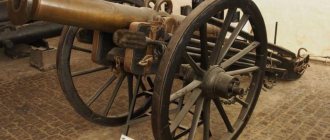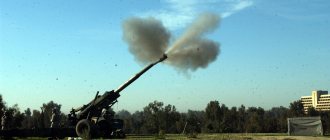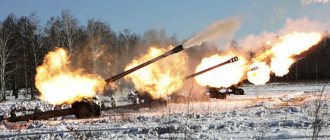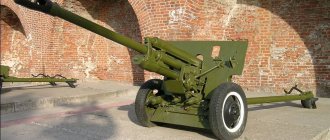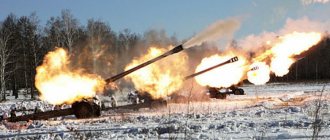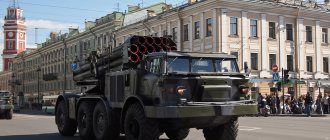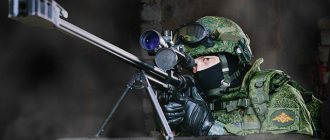ARTILLERY
ARTILLERY (French artillerie, from Old French atillier - to prepare, equip), 1) type of weapon (artillery pieces with their means of transportation and ammunition, combat support means - fire control systems, means of artillery reconnaissance, meteorological observation and topographical support); 2) branch of the military (formations, units, units and their command and control units equipped with artillery weapons); since 1961 father. A. is part of the united branch of the military - the Missile Forces and Artillery of the Ground Forces (SV); 3) the science of the structure, properties and methods of combat use of A.
Based on the branch of the armed forces, a distinction is made between air force, air force (aviation artillery) and naval air force. A. The ground force consists of batteries (4–6 guns, mortars, combat vehicles of multiple launch rocket systems - MLRS, combat vehicles of anti-tank guided missiles - ATGM), divisions (2-4 batteries), regiments or brigades (3-4 divisions) and artillery divisions (several regiments or brigades); According to its organizational affiliation, it is divided into military (field) artillery, which is part of combined arms formations, units and subunits, and reserve artillery. command - ARGC. Military aviation, in turn, is divided into army (at the beginning of the 21st century only in the Northern Forces of the Russian Federation), corps, divisional, regimental and battalion. Aviation artillery weapons - aircraft guns (at the beginning of the 21st century - caliber 20-45 mm, rate of fire 300-1800 rounds per minute, effective firing range up to 2 thousand m), ammunition for them, sighting and support systems installed on planes and helicopters. Marine artillery (coastal and ship) is divided into large (180–406 mm and more), medium (100–152 mm), and small (up to 100 mm) caliber guns. Coastal artillery (stationary and mobile - railway, self-propelled and towed) is designed to destroy enemy ships and assist friendly ships and ground forces operating in coastal areas. Shipborne artillery (turret and deck) is designed to destroy surface, coastal and air targets, and is subdivided into artillery. Ch. caliber, universal and anti-aircraft. According to their purpose, they distinguish between ground artillery (cannon, howitzer, anti-tank, rocket, mountain and mortar) and anti-aircraft (in the RF Armed Forces it is organizationally part of the air defense of the ground forces); according to the method of movement - self-propelled, towed, railway and stationary.
Basic A.'s task is fire destruction (suppression, destruction) of enemy personnel, fire weapons, military equipment, engineering structures, support of combined arms units and formations. A. Fire in the offensive is used for fire preparation and support of the attack, fire support for the advance of troops in the depths of the enemy’s defense, in defense - for counter-preparation (with the aim of disrupting the enemy’s attack), repelling enemy attacks, supporting counterattacks of friendly troops, etc. Fire A. according to the methods of preparation and conduct, tactical purpose, it is divided into barrage, concentrated, massed, as well as barrage, etc. The effectiveness of artillery fire is ensured by the work of artillery reconnaissance, the massing of fire at ch. direction, concentration on the most important goals, sudden use of A.
The emergence of art became possible after the invention of gunpowder. It replaced throwing machines (see Throwing weapons). For the first time, firearms were used by the Arabs in conquest. 13 – beginning 14th centuries From the 1320s it penetrated through Spain into the West. Europe. The earliest news of the use of A. in Rus' dates back to 1382.
Guns of the 14th–18th centuries: 1 – bombard (late 14th century); 2 – heavy weapon (15th century); 3 – arquebus (16th century, Russia); 4 – unicorn (1757, Russia).
The first firearms (used only during the siege and defense of fortresses) were an iron pipe with a solid bottom, loaded from the muzzle, or a pipe loaded from the breech with an inserted charging chamber into which a powder charge was poured. The trunks were fixed into the tree. deck. The ammunition used was stone, iron or lead cannonballs and stone buckshot. They switched from forging tools from iron to casting them from bronze in the 15th century. There appeared guns (in the Russian state - squeaks), bombards and mortars (mounted guns), howitzers. From the end 15th century For the casting of guns used in the navy and fortresses, cast iron was also used along with bronze. In battle, the guns were serviced by the craftsmen who made them. In Europe, every major city made its own artillery pieces. In Russia, the process of their manufacture was initially centralized: in 1475 the Cannon Hut (later the Cannon Yard) was opened in Moscow; the most famous Russian the cannon masters were Mikula Krechetnikov and Yakov. Wheeled carriages and sighting devices in the form of a rear sight and front sight appeared in the artillery, which significantly increased the maneuverability of the artillery and the accuracy of fire and made it possible to use it in field battles.
With the invention of the artillery scale in 1540 by the Nuremberg mechanic G. Hartmann, it became possible to organize the calibers of guns; from the end 16th century in A. explosive shells were used. The improvement of guns and the complication of tasks led to the division of artillery (in Russia it was served by specially trained people - gunners and squeakers; until the beginning of the 18th century, artillery was called “outfit”) into serf (“city outfit”), siege (“battering outfit”) "), field ("small outfit"). All R. 16th century Regimental army appeared: it first appeared in Russia as part of the Streltsy army (in the 1560s, the Pushkar Order was created for the leadership of Russian army). At the same time in the 16th–17th centuries. the foundations of artillery science were born, the works of N. Tartaglia “On the New Science” (1537, Venetian Republic), O. Mikhailov (Rodishevsky) “Charter of Military, Cannon and Other Affairs Concerning Military Science” (1607, supplemented in 1621) appeared. D. Uffano “Treatise on Artillery” (1613, Spain). Cannon casting was improved, with remarkable Russian. masters of the 16th–17th centuries. there were Ignatius, K. Ganusov, S. Dubinin, I. Falk, A. Chokhov.
The first attempt to create rifled guns was made in Russia at the beginning. 17th century Guns with screw rifling were also used in other countries, but they were not widely used either there or in Russia at that time. From the 2nd half. 17th century The casting of guns was ordered by caliber, length and weight, and drawings began to be used for their manufacture. Practical The firing range was 400–800 m.
The further spread of A. led to an understanding of the tactics of its use. One of the founders of tactics is A. Swede. King Gustav II Adolf, who widely used artillery (including light cannons) in the Thirty Years' War of 1618–1648, abandoned the uniform distribution of field artillery along the entire front and placed it on the battlefield in three groups: two groups on the flanks and one is in the center of the battle formation of troops. He used artillery reserves for the first time to mass fire.
The emergence of regular A. in Europe dates back to the 2nd half. 17th century In Russian army it was first created by Peter I; was then divided into regimental, field, siege and serf. The guns were divided into cannons (they fired cannonballs and grapeshot), howitzers (with grenades, grapeshot, etc.) and mortars (with bombs); the practical firing range did not exceed 1000 m. In 1699, the position of General Feldzeichmeister was established, in 1701 the Pushkarsky order was transformed into the Artillery order, in 1702 the formation of cavalry artillery began (regimental artillery crews of the dragoon regiments were mounted on horses; later, in 1794, cavalry troops were formed - permanent artillery companies). For training officers at the beginning. 18th century artillery schools were established (in 1762 - the Artillery and Engineering Gentry Cadet Corps). At the same time, the Hartmann artillery scale and cap loading were introduced, strict uniformity was established in the manufacture of guns and ammunition, and the number of calibers was reduced to 12.
A system of unified artillery pieces for the first time in the West. Europe adopted into service in France in 1732 (developed by J. F. de Vallières). The number of gun calibers was limited, precise design data were determined for each type, and acceptance of guns in arsenals was introduced. The unification of existing weapons was accompanied by an increase in the number of their types. More attention was paid to reducing the weight and mobility of guns. In Austria, I. V. von Lichtenstein adopted light field guns and howitzers with elongated frames and carriage boxes between them in 1745, which made it possible to transport gun servants on carriages; in Prussia, Frederick II the Great also introduced light guns at the beginning of the Seven Years' War of 1756–63 . In Russia, an attempt was made to create universal weapons; the so-called Feldzeichmeister P.I. Shuvalov adopted them for service. secret howitzers with an elliptical bore for firing buckshot at the front (1753–58), as well as unicorns (1757) - elongated howitzers with a conical charging chamber that fired all types of ammunition (were in service with the Russian army for over 100 years). In France J.-B. Gribeauval in 1765 and 1776 finally unified guns and carriages, introduced new sights, a uniform battery organization, developed firing tables for guns, and O. F. L. de Marmont in 1803 reduced the number of calibers, simplified the design of artillery carts and limbers. In Russia, imp. Paul I and A. A. Arakcheev introduced lighter guns of the systems of 1797 and 1805. The first combat missiles appeared in the army: in the end. 18th century they were used by the troops of Haidar Ali in India, in the beginning. 1800s – in British army, in 1826–27 - in Russia. army.
The increase in mobility of artillery made it possible to make changes in the tactics of its use and the order of its organization. Frederick II the Great began to direct A. to the most critical sectors of the battle, and in 1759 he formed the A. Franz cavalry in Prussia. imp. Napoleon I began to more widely use the massing of artillery fire and use the artillery reserve (in the Russian army, these tactical techniques were used in the Battle of Borodino in 1812), concentrated the leadership of artillery during the battle in the hands of one commander (in the Russian army - for the first time in the Battle of Pultus 1806), attached great importance to the interaction of A. with other branches of the military. In Russia the main The organizational and combat unit of Azerbaijan became a 12-gun company in 1796, and in 1806–07 it was consolidated into brigades consisting of infantry and cavalry divisions. A. began to be used at night (for the first time by Russian troops in 1806 in the battle with French troops near Czarnow in Poland during the Russian-Prussian-French war of 1806–07).
New tactics were born on the battlefield and as a result of the development of science and special forces. education. The first textbooks on A. grew up. The authors were “Initial knowledge of theory and practice in artillery” by M. V. Danilov (1762) and “Artillery proposals for training noble youth...” by I. A. Velyashev-Volyntsev (1767, 1777). Among the large state and military figures prof. The artillerymen were A. A. Arakcheev, who was educated in the Artillery and Engineering Gentry Cadet Corps, and Napoleon, who learned a lot from J. du Taille, who, in turn, was a student of J.-B. Gribeauval. Development grew. artillery science 1st half. 19th century associated with the names of E. Kh. Wessel, I. G. Gogel, A. I. Markevich - the authors of textbooks for the training of artillery officers. In 1820, the Mikhailovsky Artillery School was created in St. Petersburg, on the basis of the officer classes of which the Mikhailovsky Artillery Academy was opened in 1855.
In the 1st half. 19th century The idea of creating rifled guns was revived again: in 1846, the Sardinian major G. Cavalli manufactured in Sweden a 30-pound rifled breech-loading casemate gun (during tests it showed good range and firing accuracy, but insufficient workmanship and design flaws of the gun did not allow it to be adopted for service). Similar work was later carried out in Great Britain (W. Armstrong and J. Whitworth), Prussia, France and the USA. At the same time, in 1850 A. Krupp (see article Krupp) began regular industrial activity in Prussia. production of guns with steel barrels. The Crimean War of 1853–56 showed that smooth-bore muzzle-loading aircraft had exhausted its combat capabilities. The first rifled guns (first bronze and muzzle-loading) appeared in service in France (1857), Great Britain and the Austrian Empire. (1859), Russia (1860), Prussia (1861). Since 1864, A. Krupp began manufacturing rifled breech-loading guns with his own wedge breech. designs. The abandonment of guns loaded from the muzzle was made possible by the invention by the American Broadwell of a chamber seal ring, which he proposed growing up. government in 1863. Rearmament grew. rifled army A. occurred during the military reforms of the 1860–70s. Initially, bronze and cast iron rifled breech-loading guns of the 1867 model came into service (increased shot power led to the equipping of field artillery guns with iron carriages in 1868), and from 1878 - rifled breech-loading steel guns, called guns of the 1877 model. Combat training and supply of artillery, development and the production of artillery weapons was supervised by the Main Artillery Directorate (formed in 1862).
At the same time, a number of scientists (in Russia - P. M. Albitsky, A. V. Gadolin, N. A. Zabudsky, N. V. Kalakutsky, A. S. Lavrov, N. V. Maievsky, D. I. Mendeleev, P. L. Chebyshev, D. K. Chernov; abroad - K. Gauss, I. Didion, G. Piobert, A. F. Siacci, etc.) major discoveries were made in fundamental and applied sciences related to sciences A special contribution to the development of artillery weapons was made by V. S. Baranovsky (see article Baranovsky), who in 1874 created a 2.5-inch rapid-fire cannon, which had all the basics. features of modern guns
Horse guns 19 – beginning 20th centuries: 1 – 75 mm cannon (1897, France); 2 – 76 mm gun (1902, Russia); 3 – 76-mm anti-aircraft gun (1915, Russia); 4 – 122 mm howitzer (1910, Russia).
During the Russian-Tour period. During the war of 1877–78, methods of zeroing and adjusting gun fire (V.N. Shklarevich), and shooting from closed firing positions (N.L. Chebyshev) were invented and tested. At the same time, observation posts appeared near the front line, and engineering equipment for positions began to be used both in defense and before the offensive. Tactical The lessons of this war are the need to concentrate A. fire on areas where the enemy’s defenses can be broken through from different firing positions, as well as artillery planning. preparation and control of artillery fire at all stages of the battle, creation of artillery headquarters. The invention of smokeless gunpowder (pyroxyl gunpowder in 1884 by the French engineer P. Viel; pyrocolloid gunpowder in 1890 by D. I. Mendeleev) and high explosives for filling projectiles gave a new impetus to the development of artillery and an increase in its combat power. At the Putilov plant in St. Petersburg, a 3-inch field rapid-fire gun of the 1900 model was developed; in 1902 it was improved with the participation of leading artillery scientists led by N. A. Zabudsky (became called the 1902 model gun, was in service with the Russians and Soviets A. over 40 years old).
The Russo-Japanese War of 1904–05 showed the need for heavy field artillery (after the war, the Russian army adopted 122 mm, 152 mm field howitzers, and a 107 mm field gun. During the defense of Port Arthur in 1904–05, midshipman S. N. Vlasyev and Captain L. N. Gobyato invented a mortar, which made it possible to effectively hit the enemy in closely located shelters.To reduce the losses of A., the practice of firing from indirect firing positions was finally established, command and observation posts became an obligatory element of the battle formation of A. The role of reconnaissance, new means of communication (including telephone) and centralized air control in battle has increased immeasurably.
By the beginning of the First World War of 1914–1918, the total number of guns in the warring countries was 24.8 thousand guns. Basic part - light field guns of 65–77 mm caliber: 77% A. Russia, approx. 100% - France, 73% - Germany and 44% - Austria-Hungary. Field howitzer artillery of 105–155 mm caliber accounted for 10.6% of the artillery of Russia, 13.8% of Germany and 27% of Austria-Hungary. During the war, A. showed high combat effectiveness, becoming the main. destructive weapon on the battlefield (infantry losses from A. fire increased to 75% compared to 14% in the Russian-Japanese war). It had a decisive influence on the way combat operations were conducted, forcing the warring parties to switch from mobile operations to trench warfare. The share of Armenia in the total number of troops increased sharply (for example, in France from 18.1% in 1915 to 35.7% in 1918). The number of guns in the armies of the warring countries increased more than 3 times and amounted to 84.8 thousand. The greatest growth was observed in heavy artillery. New types of artillery appeared: anti-aircraft, aviation; Mortars became widespread; a need arose for anti-tank artillery. In all countries, the ARGC was formed (in the Russian army - heavy artillery for special purposes), intended to strengthen the artillery that operated in Ch. direction. Range of artillery systems on Wed. increased by 15–30%. Samples of ultra-long-range and heavy-duty guns (caliber up to 500 mm) were used, but only as unique specimens, for example. German "Paris Cannon" (firing range up to 120 km). Incendiary, smoke, sighting and chemical weapons began to be used. shells. Ammunition consumption many times exceeded pre-war plans and calculations; during the war years the following were consumed: A. Russia - up to 50 million shells of all calibers, Austria-Hungary - up to 70 million, France - approx. 190 million (only 75 mm and 155 mm), Germany - approx. 272 million shells. Means. Artillery reconnaissance was developed (tethered balloons and spotter aircraft were used, instrumental reconnaissance instruments were improved, and sound-metric stations were used to detect firing enemy guns). New means of communication - radio and telephone - have made it easier to control aircraft, ensuring the speed of information transfer. The use of cars and tractors contributed to increasing the maneuverability of artillery units and subunits and the efficiency of their support. Views on the combat use of artillery underwent significant changes: artillery preparation for an attack became mandatory by 1915. Its duration sometimes reached 10–16 days, but by 1917 there was a transition to short but powerful artillery bombardments. The density of artillery increased from 20–25 guns per 1 km of front in breakthrough areas to 100–140, and even to 188 (the offensive of the French troops at Malmaison in October 1917). New principles for the use of artillery have been developed and applied, which have not lost their importance to this day: sudden artillery fire without sighting (based on full preparation of data), new types of fire (barrage, mobile barrage, as well as a fire shaft), preparation and support of an attack to the entire depth of the battle.
In the 2nd half. 1920–30s in plural countries, the aircraft has been modernized (range, rate of fire, firing angles, etc. have been increased). In the USSR in the 1930s. New light and heavy artillery guns, mortars, anti-tank, anti-aircraft guns and high-power guns were created, developed by the design bureaus of V. G. Grabin, I. I. Ivanov, M. N. Loginov, F. F. Petrova, B. I. Shavyrina. Work on the development of missile weapons was led by I. T. Kleymenov, G. E. Langemak, N. I. Tikhomirov. New guns have been created for tanks, aircraft and naval warships. In all types of artillery, new artillery shells of various types have been adopted. appointments. Previously existing methods of zeroing and shooting to kill have been improved and new methods have been developed. At the same time, methods of artillery support for the attack were introduced: barrage of fire, sequential. concentration of fire or their combination. The technique of counter-battery warfare was improved. Means. contributions to the development of the theory of shooting and combat use of artillery, and the design of guns were made by the owls. scientists A. A. Blagonravov, P. A. Gelvikh, I. P. Grave, V. D. Grendal, N. F. Drozdov, V. G. Dyakonov, V. V. Mechnikov, Ya. M. Shapiro and others .Preparation of team and technical staff. personnel for A. was carried out by the Artillery Academy named after. F. E. Dzerzhinsky, artillery schools and courses.
Soviet guns 20th century: 1 – 122-mm howitzer M-30 (1938); 2 – 76-mm ZIS-3 gun (1942); 3 – 85-mm anti-aircraft gun (1939); 4 – MLRS BM-13 “Katyusha” (1941).
The further development of artillery, especially its new types (anti-tank, jet, self-propelled), was accelerated by the Second World War of 1939–45, and for the USSR by the Great Patriotic War of 1941–45. Despite the increased strength of tank forces supported by aviation, it was revealed that they were unable to break through fortified defenses without the support of A. In the warring countries, new field, anti-tank, self-propelled guns and MLRS were adopted. Massaging A. was widely used in Ch. directions, especially in the Red Army (up to 250–300 or more guns per 1 km of breakthrough area). The total number of guns and mortars of the military artillery of the Red Army increased by 5 times, the number of guns of the ARGK - by 9 times (accounted for about 50% of the entire army of the SV). In June 1941, the first MLRS BM-13 “Katyusha” was put into service (designers of combat vehicles - A. G. Kostikov, I. I. Gvai). In the shortest possible time at hand. V. G. Grabina, F. F. Petrova, Zh. Ya. Kotin, L. I. Gorlitsky created and adopted anti-tank guns, self-propelled artillery guns, etc. (including the 76-mm ZIS- divisional gun 3 - one of the best weapons of the 2nd World War). In 1942, sub-caliber and cumulative armor-piercing shells appeared. Artillery brigades and divisions (1942) and breakthrough artillery corps (1943) were created in the ARGK. A system for organizing anti-tank defense has been developed (the basis is strong points and a strong artillery anti-tank reserve). In the Battle of Stalingrad 1942–43 Owls. For the first time, the troops fully used a new form of artillery support for the offensive. actions - artillery offensive (made it possible to continuously ensure a breakthrough of the enemy’s defense to the full depth). Reactive artillery developed rapidly. Guards mortar units received MLRS BM-8-48, BM-13, BM-31-12 (chief designer of combat vehicles V.P. Barmin). By 1945, 519 divisions of the jet A. Sov were operating. During the war, Azerbaijan received from industry 775.6 million artillery and mortar rounds and 12.5 million rockets.
After the 2nd World War in the Soviet Union. Union, Western countries Europe, the USA, Japan, China and a number of other countries, aircraft continued to improve - its range, accuracy, rate of fire, maneuverability and controllability increased. New artillery systems have been created: towed and self-propelled howitzers, cannons and gun-howitzers, anti-tank self-propelled guns; self-propelled and towed mortars, MLRS. Nuclear artillery appeared (in the USSR - self-propelled 406-mm artillery and 420-mm mortar installations), the so-called reserve artillery of the Supreme High Command was developed. triplex - 180-mm cannon, 210-mm howitzer and 280-mm mortar on a single carriage, developed MLRS with turbojet shells. In the development of owls. barrel A. in the end 1950s There was a temporary decline due to the fact that priority was given to the development of missile weapons.
| Modern domestic and foreign artillery | |||||
| Name of the weapon (installation, system), year of adoption | A country | Firing range, km | Soon firing rate, rounds/min | Projectile weight, kg | Weight of gun, t |
| Towed artillery pieces | |||||
| 122 mm howitzer 2A18 (1960) | Russia | 15,3 | 6-8 | 21,8 | 3,3 |
| 125 mm PT gun 2A45 M (1988) | Russia | 12,2 | 6-8 | 23 | 6,58 |
| 152 mm gun 2A36 (1979) | Russia | 27,5; 32,8* | 5-6 | 46 | 9,76 |
| 152 mm howitzer 2A65 (1986) | Russia | 24,7 | 7 | 43,6 | 6,8 |
| 152 mm howitzer 2A61 (1991) | Russia | 15 | 6-8 | 43,6 | 4,3 |
| 155 mm howitzer M198 (1978) | USA | 24; 30* | 4 | 43,5 | 7,17 |
| 155 mm howitzer FH70 (1976) | Germany, Great Britain, Italy | 24; 30* | 6 | 43,5 | 9,3 |
| 155 mm TR gun (1989) | France | 24; 30,5* | 2-6 | 43,2 | 9,5 |
| Self-propelled artillery guns | |||||
| 122 mm howitzer 2S1 (1970) | Russia | 15,3 | 4-6 | 21,8 | 15,7 |
| 152 mm howitzer 2SZ (1972) | Russia | 17,3 | 3-4 | 43,6 | 27,5 |
| 152 mm howitzer 2S5 (1979) | Russia | 27,5; 32,8* | 5-6 | 46 | 28,2 |
| 152 mm howitzer 2S19 (1989) | Russia | 24,7; 30* | 7-8 | 43,6 | 42,5 |
| 155 mm M107 gun (1962) | USA | 32,7 | 2 | 68 | 28 |
| 155 mm gun F-1GCT (1976) | France | 23,5; 30* | 8 | 42 | 42 |
| 155 mm howitzer AS90A (1978) | Great Britain | 24,7; 32 | 6 | 43,5 | 45 |
| 155 mm howitzer M109 A6 (1991) | USA | 18,1; 24* | 4 | 43,5 | 24,1 |
| 155 mm howitzer PzH-2000 (1996) | Germany | 30; 40 | 9 | 43,5 | 55 |
| 203 mm howitzer M110 A2 (1978) | USA | 21,3; 29,1* | 1 | 92,5 | 28,4 |
| 203 mm gun 2S7M (1983) | Russia | 37,5; 47,5* | 2,5 | 110 | 47,5 |
| Mortars, combined guns | |||||
| 82-mm automatic mortar 2B9M (1979) | Russia | 4,3 | 100-120 | 3,1 | 0,632 |
| 82 mm mortar 2B14-1 (1983) | Russia | 4,3 | 24 | 3,1 | 0,039 |
| 106.7 mm self-propelled mortar M106A1 (1964) | USA | 5,7 | 18-25 | 12,3 | 12 |
| 120 mm self-propelled mortar M113A1GPzM (1968) | Germany | 6,2 | 5-10 | 12,9 | 11,3 |
| 120 mm mortar 2S12 (1979) | Russia | 7,1 | 10-15 | 15,9 | 0,21 |
| 120 mm gun 2B16 (1986) | Russia | 8,9 (7,2); 12,8* | 8-10 | 17.3 (mines 16.3) | 1,2 |
| 120-mm mortar Kb (M-285) (1990) | Israel | 7,2; 10,5* | 5-6 | 13,2 | 0,14 |
| 120 mm self-propelled gun 2S23 (1991) | Russia | 8,9 (7,2); 12,8* | 8-10 | 17.3 (mines 16.3) | 14,5 |
| 120 mm self-propelled gun AMS (1995) | Great Britain | 6,5; 12* | 4-8 | *** | 15 |
| 160-mm mortar M-160 (1949) | Russia | 8 | 3 | 41,1 | 1,3 |
| 240 mm mortar M-240 (1950) | Russia | 9,7 | 1 | 130,7 | 3,61 |
| 240-mm self-propelled mortar 2S4 (1972) | Russia | 9,7; 19,8* | 1 | 130,7 | 27,5 |
| Multiple launch rocket systems (MLRS) | |||||
| 110 mm MLRS LARS-2 (1981) | Germany | 14,7-25 | 36** | 34 | 17,5 |
| 122-mm MLRS 2K51 (“Grad”) (1963) | Russia | 20,4 | 40** | 66,4 | 13,7 |
| 122 mm MLRS Type 83 (1983) | China | 20,6 | 40** | 66 | 29,9 |
| 122 mm MLRS Firos-30 (1987) | Italy | 34 | 40** | 65 | 17,3 |
| 220-mm MLRS 2K57 (“Hurricane”) (1976) | Russia | 34 | 16** | 280 | 20,2 |
| 227/240 mm MLRS MLRS (1981/2005) | USA | 32-40/sv. 60 | 12** | 307 | 24,6 |
| 273 mm MLRS Type 83 (1983) | China | 40 | 4** | 484 | 17,5 |
| 300 mm MLRS 2K58 (“Smerch”) (1987) | Russia | 70 | 12** | 800 | 43,7 |
| * Firing range of an active-missile projectile (mine). ** Number of guides. *** It is possible to fire ammunition of various standards. | |||||
Modern artillery pieces: 1 – 122 mm howitzer 2A18 (1960, USSR/RF); 2 – 152-mm self-propelled howitzer 2S19 MSTA-S (1989, USSR/RF); 3 – 300-mm MLRS “Smerch” (1984, USSR/RF); 4 &nda…
In A. developed countries of the world in the 1970–1990s. new types of artillery and rocket shells have appeared: active-reactive (extended range), with ready-made lethal elements, cluster with combat elements (including homing), adjustable and guided, nuclear, etc. The use of target detection radars, laser range finders and target illumination devices, infrared devices and sights, meteorological radars. stations, topographical means. bindings, spotter helicopters, etc. made it possible to significantly improve the accuracy of shooting, as well as reduce the time required to open fire. Fire control vehicle systems have been developed and adopted for service. In the USSR in the 1970s–80s. A series of modern ones entered service. self-propelled, towed guns, mortars and MLRS; their designers are V. A. Golubev, G. I. Sergeev, M. Yu. Tsiryulnikov, Yu. N. Kalachnikov, Yu. V. Tomashov, A. F. Belousov, N. S. Popov, V. K. Filippov and others. The MLRS adopted for service had no analogues abroad at the time of their creation: 122-mm “Grad” (1963), 220-mm “Hurricane” (1976) and 300-mm “Smerch” (1987) (chief designers A. N. Ganichev and G. A. Denezhkin). The armies of NATO member countries are armed with 227/240-mm MLRS MLRS (since 1981), etc. Scientific. Coordination of research and development in the field of agriculture in the Russian Federation is carried out by the Russian Federation. Academy of Missile and Artillery Sciences. The training of artillery officers is carried out in the Mikhailovskaya military. Artillery Academy, Kolomna, Kazan and Yekaterinburg Higher Artillery Command Schools (institutes), Penza and Tula Artillery Engineering Institutes.
Interesting Facts
- Most of the famous Katyushas used during the Great Patriotic War were based on American cargo transport vehicles - Stude Baker. The reason was that the evacuated plants and factories did not have time to produce the required ZIS-6s, which were originally equipped with BMP-13s. From 1942 to 1945 The United States delivered trucks to the USSR under the Lend-Lease program.
- According to Golitsyn’s chronicle, the very first howitzer salvo was heard on the territory of Russia in 1389, during the reign of Prince Dmitry Donskoy, and Russian howitzers, purchased by Russians abroad along with guns, were used for the first time.
Anti-tank artillery
Along with the creation of highly effective anti-tank missile systems, significant attention is paid to the development of anti-tank artillery guns. Their advantages over anti-tank missiles lie primarily in their relative cheapness, simplicity of design and use, and the ability to fire around the clock in any weather.
Russian anti-tank artillery is moving along the path of increasing power and caliber, improving ammunition and sighting devices. The pinnacle of this development was the 100-mm MT-12 (2A29) “Rapier” anti-tank smoothbore gun with an increased muzzle velocity and an effective firing range of up to 1,500 m. The gun can fire the 9M117 “Kastet” anti-tank missile, capable of penetrating armor up to thick behind dynamic protection. 660 mm.
The towed PT 2A45M Sprut-B, which is in service with the Russian Federation, also has even greater armor penetration. Behind dynamic protection, it is capable of hitting armor up to 770 mm thick. Russian self-propelled artillery in this segment is represented by the 2S25 Sprut-SD self-propelled gun, which has recently entered service with paratroopers.
Artillery ammunition
Artillery ammunition can be either unitary or separate loading. With unitary ammunition, the projectile itself, the cartridge case and the powder charge are connected into a single whole.
Unitary projectile
With separate loading, the projectile and the charge are not connected to each other, but are loaded in turn.
Separately loaded projectile
Thus, artillery, be it ground, naval or aviation guns, is and will be in fact the main weapon for destroying enemy personnel and equipment at close ranges. If at long distances rocket weapons are indispensable, then at close distances you cannot do without guns, mortars and MLRS.
Russian Coastal Artillery
Coastal troops in the Russian Federation as a branch of independent forces of the Navy were formed in 1989. The basis of its firepower is made up of mobile missile and artillery systems:
- "Redoubt" (rocket).
- 4K51 "Rubezh" (missile).
- 3K55 "Bastion" (missile).
- 3K60 "Bal" (rocket).
- A-222 "Bereg" (artillery 130 mm).
These complexes are truly unique and pose a real threat to any enemy fleet. The newest "Bastion" has been in combat duty since 2010, equipped with Onyx/Yakhont hypersonic missiles. During the Crimean events, several “Bastions”, demonstratively placed on the peninsula, thwarted plans for a “show of force” by the NATO fleet.
Russia's newest coastal defense artillery, the A-222 Bereg, operates effectively against small-sized high-speed vessels moving at a speed of 100 knots (180 km/h), medium surface ships (within 23 km from the complex), and ground targets.
Heavy artillery as part of the Coastal Forces is always ready to support powerful complexes: the Giatsint-S self-propelled gun, the Giatsint-B howitzer gun, the Msta-B howitzer gun, D-20 and D-30 howitzers, and MLRS.
Flak
Russian anti-aircraft artillery is represented by the following self-propelled small-caliber systems:
- Quad self-propelled gun "Shilka" (23 mm).
- Self-propelled twin installation "Tunguska" (30 mm).
- Self-propelled twin launcher "Pantsir" (30 mm).
- Towed twin unit ZU-23 (2A13) (23 mm).
The self-propelled guns are equipped with a radio instrument system that provides target acquisition and automatic tracking and generation of guidance data. Automatic aiming of guns is carried out using hydraulic drives. "Shilka" is exclusively an artillery system, while "Tunguska" and "Pantsir" are also armed with anti-aircraft missiles.
Multiple launch rocket systems
Since the Second World War, Russian rocket artillery, as the legal successor of the USSR, has a powerful group of MLRS. In the 50s, the 122 mm 40-barrel BM-21 Grad system was created. The Russian Ground Forces have 4,500 such systems.
The BM-21 Grad became the prototype of the Grad-1 system, created in 1975 to equip tank and motorized rifle regiments, as well as the more powerful 220-mm Uragan system for army artillery units. This line of development was continued by the long-range Smerch system with 300-mm projectiles and the new Prima divisional MLRS with an increased number of guides and increased-power rockets with a detachable warhead.
Procurement is underway for a new Tornado MLRS, a bi-caliber system mounted on the MAZ-543M chassis. In the Tornado-G variant, it fires 122-mm rockets from the Grad MLRS, being three times more effective than the latter. In the Tornado-S version, designed to fire 300-mm rockets, its combat effectiveness coefficient is 3-4 times higher than that of the Smerch. The Tornado hits targets with a salvo and single high-precision rockets.
Legacy of the past
New models of Russian weapons trace their origins back to the 60s of the 20th century, when the Soviet army leadership set a course for high-quality rearmament. Dozens of leading design bureaus, where outstanding engineers and designers worked, laid the theoretical and technical basis for the creation of the latest weapons.
The experience of previous wars and analysis of the potential of foreign armies have clearly shown that it is necessary to rely on mobile self-propelled artillery and mortar launchers. Thanks to decisions made half a century ago, Russian artillery has acquired a substantial fleet of tracked and wheeled missile and artillery weapons, the basis of which is the “flower collection”: from the nimble 122-mm Gvozdika howitzer to the formidable 240-mm Tulip.
Barrel field artillery
Russian barrel artillery has a huge number of guns. They are in service with artillery units, units and formations of the Ground Forces and represent the basis of the firepower of marine units and internal troops. Barrel artillery combines high firepower, accuracy and accuracy of fire with simplicity of design and use, mobility, increased reliability, flexibility of fire, and is also economical.
Many samples of towed guns were designed taking into account the experience of the Second World War. In the Russian army, they are gradually being replaced by self-propelled artillery pieces developed in 1971-1975, optimized for performing fire missions even in conditions of a nuclear conflict. Towed guns are supposed to be used in fortified areas and in secondary theaters of military operations.
